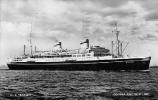|
 The
M/V Batory was a large (14,287 BRT) ocean liner of the Polish merchant
fleet, named after Stefan Batory, the famous sixteenth-Century king of
Poland. She was among the most notable tourist attractions of the
Polish seaside and among the best-known Polish ships of the time. The
M/V Batory was a large (14,287 BRT) ocean liner of the Polish merchant
fleet, named after Stefan Batory, the famous sixteenth-Century king of
Poland. She was among the most notable tourist attractions of the
Polish seaside and among the best-known Polish ships of the time.
Mobilized at the outbreak of World
War II, she served as a troop transport and a hospital ship by the
Allied Navy for the rest of the war. In 1940 she, transported allied
troops to Norway. She participated in the evacuation of Dunkirk late May
early June, taking aboard 2,500 persons. Later she carried as many as
6,000 people in one evacuation. In June to July, she secretly
transported much of Britain's gold reserves (₤40 million) from Greenock,
Scotland to Montreal, Canada for safekeeping. On 4 August 1940 she left
Liverpool with convoy WS 2 (Winston's Specials) transporting 480
children to Sydney Australia, under the Children's Overseas Reception
Board for safekeeping until the war was over. She sailed via Cape Town,
India, Singapore (where she disembarked 300 troops) and Sydney. The
journey had been a happy one, with so much music and laughter that the
Batory was dubbed the "Singing Ship" and was the subject of a book by
the same name.
She was involved in the invasion of Oran in Algeria in 1942, transported
troops to India and the invasions of Sicily and southern France, where
she was the flagship of General Jean de Lattre de Tassigny,
Commander-in-Chief of the French Army. She came under attack several
times from the ground and the air, but managed to escape serious damage
and was dubbed "the lucky ship".
Dubbed the Lucky Ship for her military career during World War II, she
was a sister to the less fortunate MS Piłsudski which was sunk in
November 1939.
Returned to Poland in 1946, she continued her civilian service,
transporting such eminents as Ryszard Kapuściński. From May 1949 through
January 1951, she was the subject of several political incidents in
which dockers and shipyard workers in the United States refused to
unload cargo from her, or to service the ship by drydocking and
painting. After these incidents, she was withdrawn from the North
Atlantic route, refurbished at Hepburn for tropic service, and sailed in
August 1951 from Gdynia and Southampton to Bombay and Karachi, via
Gibraltar, Malta, Aden, and Suez. In 1957, she returned to the North
Atlantic route. Afer retirement the Batory, like a number of other ships
became a floating hotel-restaurant-museum in Gdynia for two years. But
like most of these ventures the great idea proved unprofitable, the ship
was sold for US $570,000 to a Hong Kong scrap yard, making her last
one-way voyage during 1971.
[en.wikipedia.org/wiki/MS_Batory] |


